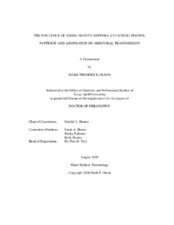| dc.description.abstract | Mosquito-borne viruses are emerging or re-emerging globally, afflicting millions of people around the world. Aedes aegypti, the yellow fever mosquito, is the principal vector of dengue, Zika, and chikungunya viruses, and has well-established populations across tropical and subtropical urban areas of the world, including the southern United States. While intense arboviral epidemics have occurred in Mexico and further south in the Americas, local transmission in the United States has been minimal. In Chapter II of this dissertation, I investigated the degree to which South Texas Ae. aegypti feed on sugar sources to help inform vectorial capacity. I analyzed sugar feeding patterns of Aedes aegypti and Culex quinquefasciatus mosquitoes using the cold and hot anthrone test. While this research affirms earlier studies that sugar feeding among female Ae. aegypti is limited, I also present evidence that the frequency of fructose feeding is only slightly less than that of male Ae. aegypti. In Chapter III, I investigated the host feeding patterns of Ae. aegypti to determine the degree of anthropophagy. Surprisingly, only 31% of Ae. aegypti blood meals were derived from humans, while 50% were from dogs and 19% from other wild and domestic animals. Using mosquito and human case data on both sides of the border, I modeled the reproductive number of Zika virus to show that wasted bites on non-amplification hosts in South Texas diluted virus transmission. In Chapter IV, I explored the global patterns of ‘aegyptism without arbovirus’ using geographic information system (GIS) and spatial modeling. I present a global map showing a gradient from high suitability for Ae. aegypti but low suitability for dengue to the other end of the spectrum where areas have similar and higher suitability for both Ae. aegypti and dengue. I then use a linear regression model to assess the correlation between this deviation and population density, gross domestic product, infant mortality rate, temperature, precipitation, and elevation. This analysis yielded several significant relationships between the deviation values and environmental and demographic factors. This dissertation advanced the field in understanding the basic biology of the world’s most important mosquito vector of viruses. | en |


